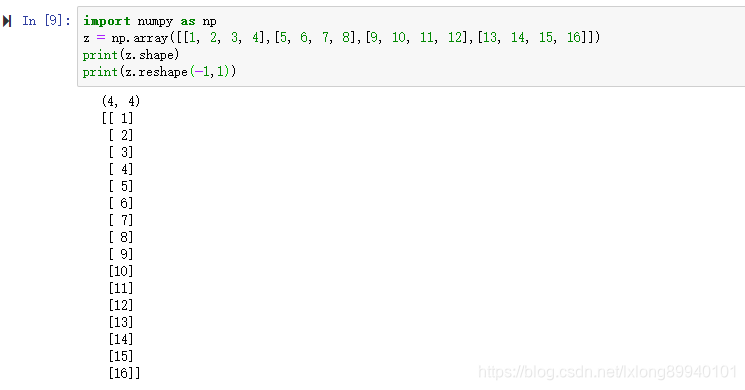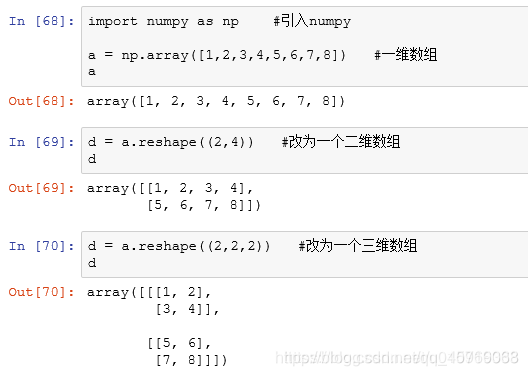转载自:https://blog.csdn.net/u010916338/article/details/84066369
shape()和reshape()都是数组array中的方法
numpy中reshape函数的三种常见相关用法
- numpy.arange(n).reshape(a, b) 依次生成n个自然数,并且以a行b列的数组形式显示
np.arange(16).reshape(2,8) #生成16个自然数,以2行8列的形式显示# Out:# array([[ 0, 1, 2, 3, 4, 5, 6, 7],# [ 8, 9, 10, 11, 12, 13, 14, 15]])- mat (or array).reshape(c, -1) 必须是矩阵格式或者数组格式,才能使用 .reshape(c, -1) 函数, 表示将此矩阵或者数组重组,以 c行d列的形式表示
reshape(m,-1) #改变维度为m行、1列reshape(-1,m) #改变维度为1行、m列-1的作用就在此: 自动计算d:d=数组或者矩阵里面所有的元素个数/c, d必须是整数,不然报错)
(reshape(-1, m)即列数固定,行数需要计算)
arr=np.arange(16).reshape(2,8)arr'''out:array([[ 0, 1, 2, 3, 4, 5, 6, 7],[ 8, 9, 10, 11, 12, 13, 14, 15]])'''arr.reshape(4,-1) #将arr变成4行的格式,列数自动计算的(c=4, d=16/4=4)'''out:array([[ 0, 1, 2, 3],[ 4, 5, 6, 7],[ 8, 9, 10, 11],[12, 13, 14, 15]])'''arr.reshape(8,-1) #将arr变成8行的格式,列数自动计算的(c=8, d=16/8=2)'''out:array([[ 0, 1],[ 2, 3],[ 4, 5],[ 6, 7],[ 8, 9],[10, 11],[12, 13],[14, 15]])'''arr.reshape(10,-1) #将arr变成10行的格式,列数自动计算的(c=10, d=16/10=1.6 != Int)'''out:ValueError: cannot reshape array of size 16 into shape (10,newaxis)'''- numpy.arange(a,b,c) 从 数字a起, 步长为c, 到b结束,生成array
- numpy.arange(a,b,c).reshape(m,n) :将array的维度变为m 行 n列。
np.arange(1,12,2)#间隔2生成数组,范围在1到12之间# Out: array([ 1, 3, 5, 7, 9, 11])np.arange(1,12,2).reshape(3,2)'''Out:array([[ 1, 3],[ 5, 7],[ 9, 11]])'''reshape(1,-1)转化成1行:

reshape(2,-1)转换成两行:

reshape(-1,1)转换成1列:

reshape(-1,2)转化成两列

shape()
import numpy as npa = np.array([1,2,3,4,5,6,7,8]) #一维数组print(a.shape[0]) #值为8,因为有8个数据print(a.shape[1]) #IndexError: tuple index out of rangea = np.array([[1,2,3,4],[5,6,7,8]]) #二维数组print(a.shape[0]) #值为2,最外层矩阵有2个元素,2个元素还是矩阵。print(a.shape[1]) #值为4,内层矩阵有4个元素。print(a.shape[2]) #IndexError: tuple index out of range
reshape()

reshape新生成数组和原数组公用一个内存,不管改变哪个都会互相影响。


)








)




)
Apache Rewrite 详解)

